There two anomalous variations (intended alterations) in the Lavery One Pound notes.
1. £1 notes dated 31.12.58: Emerald Green variation.
2. Design 2 £1 notes (1959, 1960).
In the era when the printing of Irish Legal Tender Notes moved from Waterlow and Sons Ltd. to Thomas De La Rue Ltd., variations appeared in the Lavery £1 notes, and then disappeared shortly thereafter. This is in addition to the Mulberry serial variety seen in all red-numbered denominations dated in the period 1959 to 1962 on notes printed by De La Rue.
Variations
The last run of £1 notes printed by Waterlow and Sons Ltd. were dated 31.12.58, and were printed in an attractive unusually dark emerald green. £1 notes prior to, and subsequent to this date were of the normal shade of green used on Lavery notes.
These darker green blanks have not been observed for any other date. They are an attractive, though common variety of the Lavery series LTN.
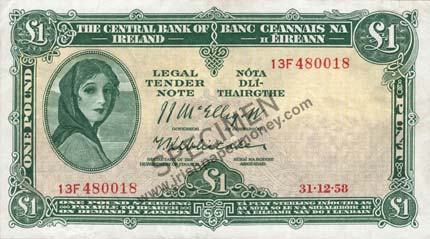
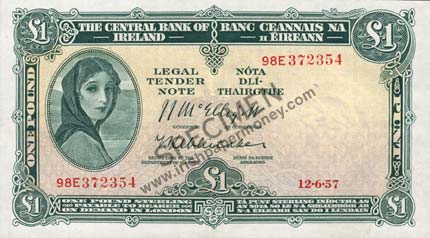
Richer emerald green 1958 £1 note compared with a normal green 1957 £1 note.
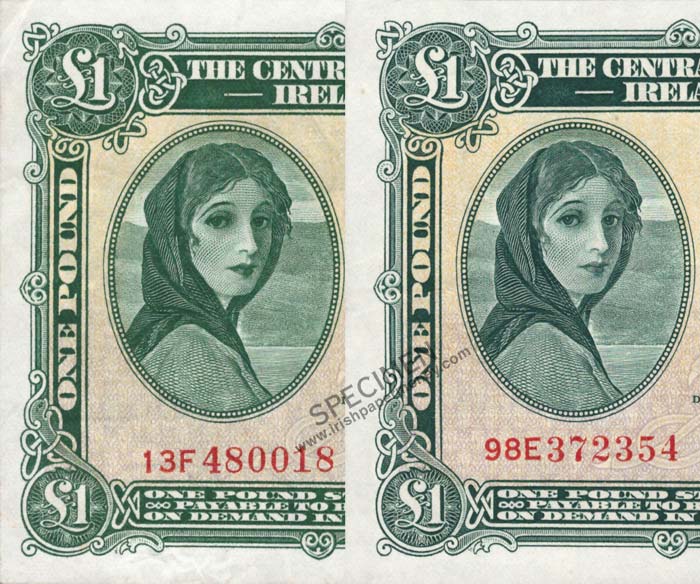
A close up of the portraits on the 31.12.58, and the 12.6.57 £1 notes showing the colour difference in the portrait area. All £1 notes dated 1958 were printed with this richer green colour.
£1 notes dated 2.9.59 and 18.5.60 are the only known dates of issue which occur as the Design 2 variety, and all notes of these dates are of this variety. The £1 notes bearing these dates were printed on the face and the reverse using different engraving plates (Design 2) to earlier and later A Series £1 notes (Design 1).
The appearance of these Design 2 notes coincides with TDLR taking over the printing of the £1 notes, starting with those dated 2.9.59. The Design 2 notes are also the first instance of later mulberry notes. It is not known why this variety occurs. A possible reason for the usage of the Design 2 engravings may be that the usual plates were not available to TDLR at the time that these £1 notes were required to be printed.
The plates used for Design 2 notes appear to have been manufactured at the same time as the Design 1 plates, around 1927, as there are Design 2 trials which date from that period. Design 2 £1 notes are very similar to those of Design 1, with subtle differences which take the form of minor changes throughout the design on both sides of the banknote.
There is also an alteration of the security features in which one feature disappears, to be replaced by a new one (See Irish Banknotes, 1999). Additionally, the portrait of Lady Lavery on notes of this variety differs slightly from that on all other notes, and is clearly a different engraving. There are other minor changes on the face of the £1 note.
After 1960, the face of the £1 note reverted to Design 1, but the reverse engraving remained as Design 2. This reverse is used on all remaining A Series £1 notes, producing a “mule” composed of a Design 1 face and a Design 2 reverse. Design 2 engravings of the portrait of Lady Lavery for other denominations were made in 1927, but not used. There is also at least one different, Design 3 portrait test known, which was never used on production notes.
The variety appears with the change of printers, and disappears again with a change of Type, after a long gap in the printage dates (the next £1 date was in 1962). This design variance adds a nice extra aspect to the LTN of this era. 2.9.59 is relatively easy to obtain in grades up to AU. Conversely, 18.5.60 is a rare note in better than EF grade.
The notes appear in the full range of mulberry shades. ‘Black’ mulberry examples of either of these dates are rare in any grade.
Design 1 and Design 2 portraits compared
The most obvious difference between Design 1 and design 2 notes is in the portrait of Lady Lavery. Illustrated below, the portrait on the left is Design 1 (1945), that in the centre is Design 2 (1960), and the portrait on the right is Design 1 (1972). The three images are all the same scale, scanned on the same device.
The Design 2 portrait (centre, 42.5x34.5mm) is significantly shorter and flatter than the two Design 1 portraits (left and right, 43.5x35mm) which are of similar size and proportions.
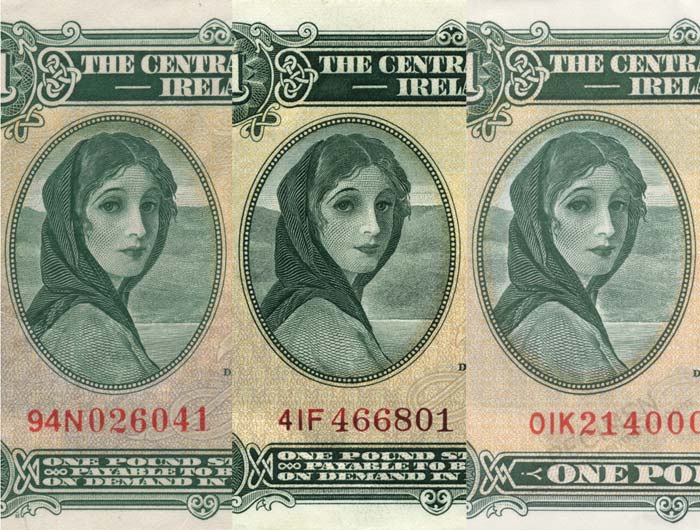
A comparison of the portraits of Lavery Design 1 (1928-58), Design 2 (1959, 1960), and reverted to Design 1 (1962-77).
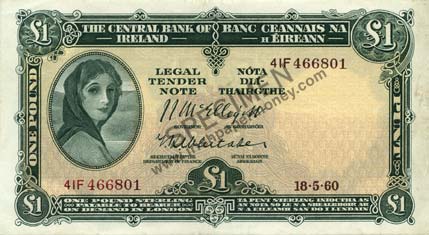
Design 2 £1 note 18.5.60. All of the colours of the notes were slightly different to those of later and earlier Design 1 notes in addition to the usage of slightly different printing plates. Thus the 1959 and 1960 notes have quite a distinct appearance. The note illustrated is also a varitone mulberry.
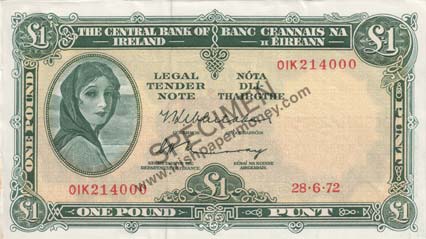
Design 1 £1 note.
Incidentally, 01K 214000 is the last £1 note to be printed by Thomas De La Rue, before the Central Bank of Ireland started printing the Legal Tender Notes at their production facility om Sandyford, Co. Dublin.
Special Sections and Articles
The Transition of Irish Currency, Irish banknotes 1918–1928
The Partition of Irish Currency, Irish banknotes 1928–1930
Banknote Design Evolution 1824 to 1916
Irish Three Pound Notes
Contemporary Forgeries of Early Irish Banknotes, ca1800-1930
Limerick Soviet Notes
Irish World War 2 Banknote Issues
Low Number Irish Banknotes
Irish Joint Stock Banks of Note Issue from 1783
Irish Legal Tender Note Specimens
Ploughman Scan Survey (PSS)
1 Pound Ploughman
5 Pounds Ploughman
10 Pounds Ploughman
20 Pounds Ploughman
50 Pounds Ploughman
100 Pounds Ploughman
Irish Ten Shilling Notes
1 Pound Note Lady Lavery
5 Pounds Lady Lavery
10 Pounds Lady Lavery
20 Pounds Lady Lavery
50 Pounds Lady Lavery
100 Pounds Lady Lavery
1 Pound Note, Queen Medb
5 Pound Note, John Scotus Eriugena
10 Pound Note, Jonathan Swift
20 Pound Note, W. B. Yeats
50 Pound Note, Turlough O'Carolan
100 Pound Note, Grace O'Malley
5 Pound Note, Sister Catherine McAuley
10 Pound Note, James Joyce
20 Pound Note, Daniel O'Connell
50 Pound Note, Douglas Hyde
100 Pound Note, Charles Stewart Parnell